After a quick and uneventful drive back to Delhi, we parted ways with our driver and caught the Shitabi Express train to Amritsar. The train was super comfy and we were served snacks, water, dinner, and dessert! Our travel agent had arranged for us to be picked up at the station, for which we were so thankful as the place was so full with people sleeping on the ground everywhere, that there was hardly anywhere to step on the floor. After sleeping in and resting, we started exploring the first of three religious practices we would encounter within just a few days.
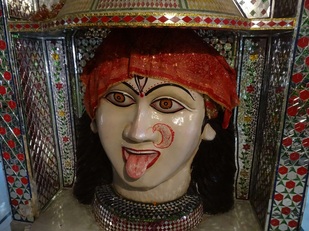
Mata Temple Statue
Hinduism is the most common religion within India, though it covers many different practices throughout the country and is said to be more of a traditional way of life. It is also thought to be the oldest living religion as it draws its roots from the Vedic religion of Iron Age India. It is difficult to fully describe Hinduism within the scope of our blog because it is a conglomeration of multiple philosophical perspectives. But here are some core ideas. Hinduism generally sees the Godhead or Brahman, as represented by 3 personalities: Brahma (creator), Vishnu (preserver), and Shiva (destroyer). Some non-dualistic sects believe that the atman, or individual soul, is just an aspect of the Brahman and that the goal of practice is to realize this unity. Other dualistic schools see Brahaman as a separate being and believe that only by worshipping him in his various forms can freedom (moksha) be found. Most of the schools agree that humans are caught up in samsara (the continuing cycle of birth, life, death, and rebirth) and that through dharma (action in accordance with reality) people can find moksha. This dharma is represented by different yogas (paths or practices) like Bhakti Yoga (path of devotion), Karma Yoga (path of right action), Raja Yoga (path of meditation) and Jñāna Yoga (path of wisdom). Despite all this talk of freedom and unity, Hinduism has also incorporated into itself the socially rigid caste system. While barely addressed in key spiritual texts, the caste system has nevertheless become intertwined with Hinduism as it divides people into classes such as priest, warrior, merchant, laborer, or untouchable (outside of class).
Our exploration of Hinduism in India continued in Amritsar with a visit to one of the most unusual temples we have encountered thus far – the Mata Temple. Dedicated to the female saint, Lal Devi, this Hindu temple’s design is a labyrinthine path taking you to your knees through fake caves and through ankle high water on other portions of the “temple route”. The whole thing is covered in mirrors and colored glass as you pass by imagery of various devas like Shiva, Ganesh, black Bhuddas and even a saint with three breasts that reminded us of Total Recall! The experience here was more akin to a fun house than a place of worship, but at the end, we were mesmerized by the beautiful singing chants of the ladies in the main temple hall. We sat here listening quietly to their devotional calls and reflected on our experience here and in India, which is truly like a game of roulette in a casino. You never know what to expect here – one day, you are inspired by the devotion and spiritual dedication of the people and the next you are shaking your head as they blatantly lie to you about travel while you cover your ears to protect them from the constant honking and noise found on the streets.

Walking through tunnels in Mata Temple
The next stop in our day was the heart of Amritsar, the Golden Temple, which is also the heart of the Sikh religion. This monotheistic belief system was founded in the 15th century in the Punjab region of India and this state remains largely populated by Sikh believers. In some ways Sikhism is easiest to define in its differences from Hinduism. It rejects the caste system and encourages nondiscrimination based on caste, creed, or gender. It encourages people to live lives as householders and not idealize the idea of the renunciant yogi who leaves all attachments to go find truth in the wilderness. To the Sikhs, God is present in everything and by meditation and right living one can break through maya (the false human view of reality) to find union with him.
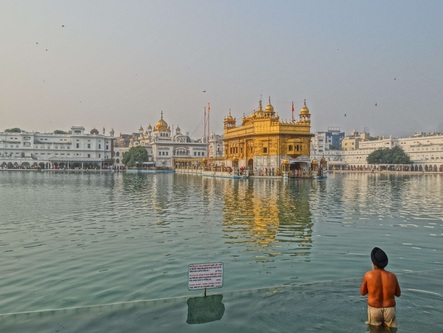
A Sikh Devotee bathing in the Pool of Nectar at the Golden Temple
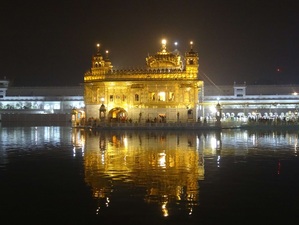
The Golden Temple is the biggest pilgrimage site for the Sikhs and every Sikh is expected to volunteer here for at least one week during their lifetime. The light shines brightly off of its gilded copper plates, all of which are situated in the middle of the sacred “pool of nectar”. Its dome represents an inverted lotus flower and gilding it took 750kg of gold! All day long, priests inside the temple recite chants from the holy book and loud speakers broadcast this throughout the complex. The most interesting experience was dining here. To honor their belief of the equality of all people, the Sikhs provide a free meal for all visitors. We lined up with the crowd and were continuously stared at unabashedly by the older Sikh men as there were not many ‘white’ visitors lining up to eat here. As usual, there were several people trying to get ahead in front of everyone by just pushing their way through. We found it terribly ironic that even in their most holy temple the Sikh people would be so impatient as to push ahead of others when there was plenty of space for everyone to eat. Once the hall cleared out from the previous group, it was our group’s turn to enter and the crowd swelled at the entrance of the double doors as people pushed and shoved to enter the empty hall and find a place on the ground. Once breathlessly seated, servers came by with buckets and served everyone a ladle or two of different kinds of dal, some type of curd, and roti. Sometimes it seems that regardless of religion, the booming population in India has made everyone act like dogs fighting over the last bone. We did find that the Golden Temple was much less hectic at night and enjoyed walking around the pool of Nectar to the soft sounds of chanting over the speaker.
The city of Amritsar was a bit stressful so we decided to head to Dharamsala a bit earlier to breathe some clean air in the mountains and get ready to see the Dalai Lama! Dharamsala rose to fame in 1959 when it became the home of the Tibetan government in exile and the 14th Dalai Lama. We found out he was teaching during our visit to India, so we decided to go up North before it gets too cold to see him. This brought us to our third religious encounter – Tibetan Buddhism. As opposed to our practice of Zen, which founder Bodhidarma espoused to be “a special transmission outside the scriptures, not relying on words and letters,” Tibetan Buddhism appears to emphasize the oral transmission of teachings and utilizing these teachings in analytic meditation. Tibetan Buddhists are encouraged to engage in internal debate over the oral teachings and alternate between this analytic meditation and calm abiding meditation. Another major difference in Tibetan Buddhism is the use of Tantric (Vajrayana) practices to attain enlightenment in a single lifetime.
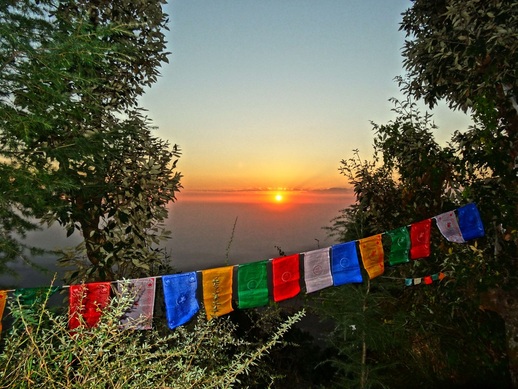
Beautiful sunset behind the Dalai Lama temple
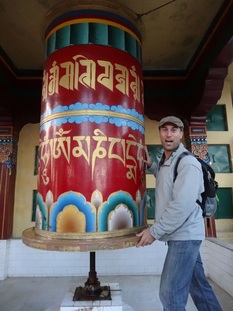
Spinning the huge prayer wheel
The Tantric practices are not shared with uninitiated disciples, which has to be done by a qualified lama. While we don’t necessarily connect with these aspects of the religion, it is a very colorful form of Buddhism with beautiful mandalas, prayer wheels, and chanting seen and heard all over the temple.
While in Dharmsala we enjoyed circumambulating around the temple at sunset, with amazing views of the Himalayas in the background and Tibetan prayer flags in the foreground. We took a day trip to the nearby Bagsu Waterfall and drank delicious lemon-ginger-honey tea at the Shiva café while the young backpackers next to us chatted nosily in a ganja induced state. We enjoyed looking at the wonderful crafts the Tibetan refugees had crafted like turquoise covered prayer wheels filled with thousands of repetitions of the compassion mantra or the delicate Thangka paintings, which are sacred mandalas painted onto cotton.
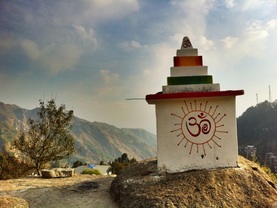
Beautiful stuppas on the hills above Dharamsala
The whole process of preparing for the teaching ended up offering a bit of a laugh in the end. We spent one morning registering for it and next day arriving early to pick out our seats for following day’s teaching. Then, on the morning of the teaching we arrived two hours early to wait. The Dali Lama entered the building and settled down on his seat and began to teach. It was then we discovered that the FM broadcast of his teaching in English didn’t work on the side of the temple we were on! We eventually moved, but still the translation wasn’t great and the teachings on the Lam Rim text proved too convoluted to capture our interest. But the experience of seeing the famous leader and teacher alone was interesting. He is smaller than I had thought but quite jolly as he appears on many photos. He likes to make some jokes while lecturing and is quite animated using many hand gestures when he teaches. At one point during his exit, we were so close to him that we could touch him (but we are pretty sure the guys with the big guns would not have been happy J!). He always tried to embrace people as he entered and left the temple and his presence inspired smiles and happiness.
After a relaxing time in Dharamsala, we took an overnight bus to Rishikesh, the self-proclaimed yoga capital of the world. More accurately we came 2km north of the town of Rishikesh to where the ashrams and yoga centers are – an area called Swarg Ashram and Lakshman Jhula. The area is littered with posters advertising many different yoga centers and teacher trainings for Westerners. We have attended some classes and looked into staying at some of the ashrams, but in truth all the classes just left us really missing our teachers in Austin. Teachers here are prone to make rough adjustments that can easily lead to injury, don’t properly warm-up students, and teach sequences of postures that are generally less creative than what we found in Texas, strange as that sounds. What was once a relatively isolated place of pilgrimage for Indians looking to meditate on the sacred Ganges has become a cluster of guesthouses and restaurants, all with multi-national menus serving white folks.
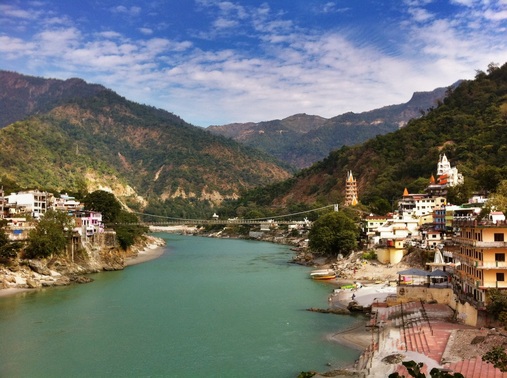
Ashrams and hotels in Rishikesh overlooking the Ganga
That’s not to say that there aren’t Indians here. The area is crowded with pilgrims and this combined with the yoga seekers has led to an overdevelopment that leaves the streets congested with honking taxis and motorbikes, leaving one’s ears buzzing after just a few minutes in the street. Despite all of this, it can’t offset the beauty of the Ganga at sunset or of the river itself.
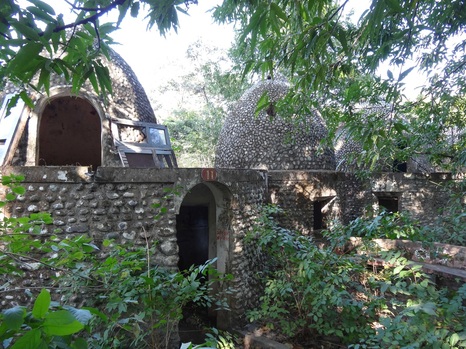
Meditating capsules
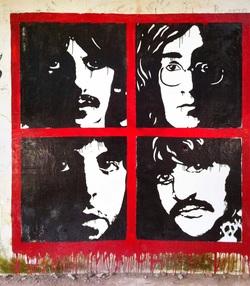
One interesting bit of history lying in ruin in the forest near Swarg Ashram is the enormous ashram of Maharishi Mahesh Yogi, the founder of Transcendental Meditation (TM). The self-proclaimed Maharishi (enlightened one) hosted the Beatles at this ashram in 1968, where they are said to have written parts of the White Album. But their stay was somewhat short-lived amid accusations of sex-scandals and profiteering by the Maharishi. TM has continued as a money making force however, and when the Maharishi died in 2008, his estate is said to be worth anywhere from 600million to nearly 2billion dollars. The ashram lost its lease on the land in 1997 and has since yielded to the forest, making for a fascinating walk through what was once a hippie style wonderland. There are hundreds of little round capsules where devotees could live on the bottom and perform meditation at the top. The complex includes many deteriorating dormitory style buildings as well as a large auditorium (since made into a shrine for the Beatles – see pic above) and the Maharishi’s old home.
This is one of our longer posts and as you can see, it is full of mixed emotions. What spiritual perspective have we been taking on this whole experience? On the one hand, the constant strain of being out in public in India has taken a toll on me as a woman. When it’s not the aforementioned noise, it’s the leering looks of the men as you walk by and the occasional grope that they try to pretend was a stumble. Combine that with the dirtiness of the place and it makes me just want to get out of here. But Jeff and I have reflected that in some ways the whole place is like a container in which you are uncomfortable to be and the only way to find peace is to accept the situation, not fight against it. In such places, you must confront your ego and either work towards loosening its grip on your outlook or find yourself in even more pain. Maybe that is why India is the heart of so many powerful spiritual practices while simultaneously being such a trying place to travel within!
The pics from these three towns are on flickr -
http://flic.kr/s/aHsjD17oST.










 RSS Feed
RSS Feed
